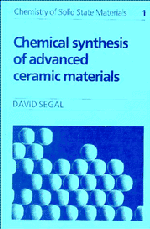Book contents
- Frontmatter
- Contents
- Preface
- Symbols
- 1 Introduction: the variety of ceramic systems
- 2 Conventional routes to ceramics
- 3 Ceramic fabrication
- 4 Sol–gel processing of colloids
- 5 Sol–gel processing of metal–organic compounds
- 6 Non-aqueous liquid-phase reactions
- 7 Polymer Pyrolysis
- 8 Hydrothermal synthesis of ceramic powders
- 9 Gas-phase reactions
- 10 Miscellaneous synthetic routes to ceramic materials
- Appendix: Determination of particle size
- References
- Index
10 - Miscellaneous synthetic routes to ceramic materials
Published online by Cambridge University Press: 04 April 2011
- Frontmatter
- Contents
- Preface
- Symbols
- 1 Introduction: the variety of ceramic systems
- 2 Conventional routes to ceramics
- 3 Ceramic fabrication
- 4 Sol–gel processing of colloids
- 5 Sol–gel processing of metal–organic compounds
- 6 Non-aqueous liquid-phase reactions
- 7 Polymer Pyrolysis
- 8 Hydrothermal synthesis of ceramic powders
- 9 Gas-phase reactions
- 10 Miscellaneous synthetic routes to ceramic materials
- Appendix: Determination of particle size
- References
- Index
Summary
Introduction
The previous six chapters have been concerned with non-conventional preparative routes to ceramic materials, that is, techniques which avoid powder mixing and milling or coprecipitation of hydroxides and oxalates. Synthetic routes not associated with sol–gel processing of both colloids and metal–organic compounds, non-aqueous liquid-phase reactions, polymer pyrolysis, hydrothermal synthesis and gas-phase reactions are the subject of this chapter. These methods are the citrate gel process, alkoxide pyrolysis, freeze-drying and rapid expansion of supercritical solutions. Different drying processes, which have been mentioned in earlier sections, are discussed here with particular reference to their role in modifying the sintering behaviour of ceramic powders.
The citrate gel process
The citrate gel process, which was developed by Marcilly & co-workers (1970), can be illustrated by the synthesis of Gd2O3-stabilised zirconia (van der Graaf & Burggraaf, 1984). In order to form an organometallic complex, citric acid was added to mixed zirconyl and Gd(III) nitrate solutions (acid/metal mole ratio = 2:1) whose pH had been increased with NH4OH to between 6 and 7.5. Other organic acids containing at least one hydroxyl and one carboxylic group such as tartaric, lactic and glycollic acid can be used. Rapid partial dehydration produced highly viscous mixtures that could be dried to amorphous gels at 373 K. The viscous ceramic precursor swelled on further heating because of decomposition of NH4NO3 after which the organometallic complex decomposed exothermically.
- Type
- Chapter
- Information
- Chemical Synthesis of Advanced Ceramic Materials , pp. 143 - 147Publisher: Cambridge University PressPrint publication year: 1989

